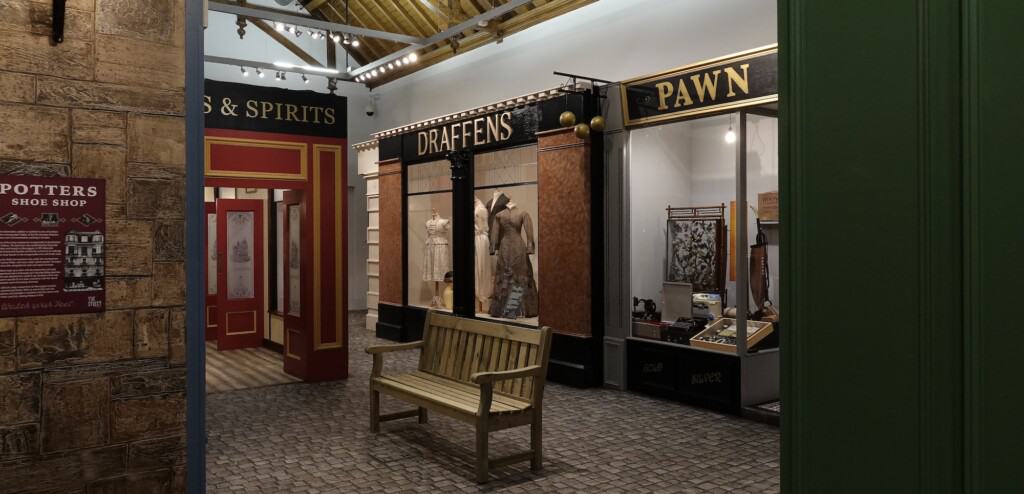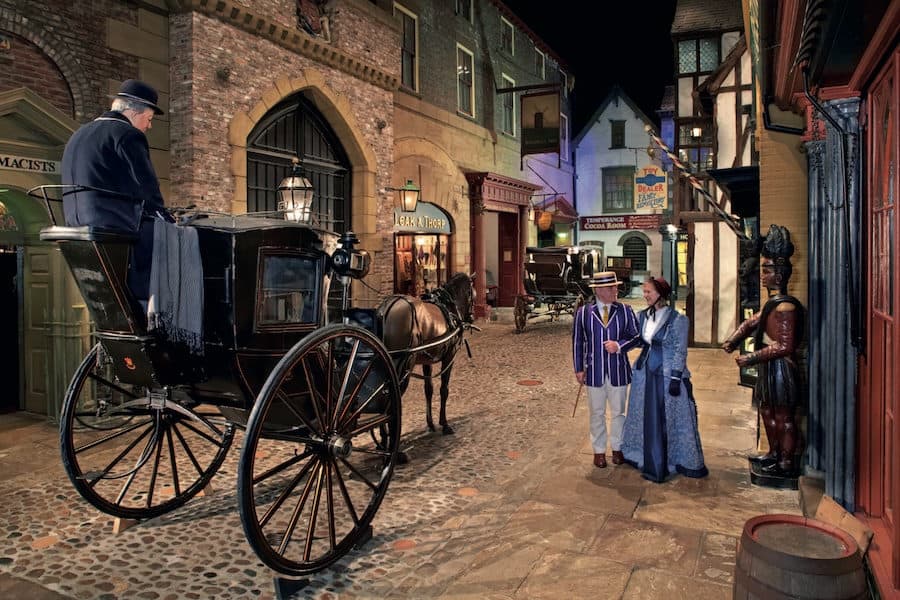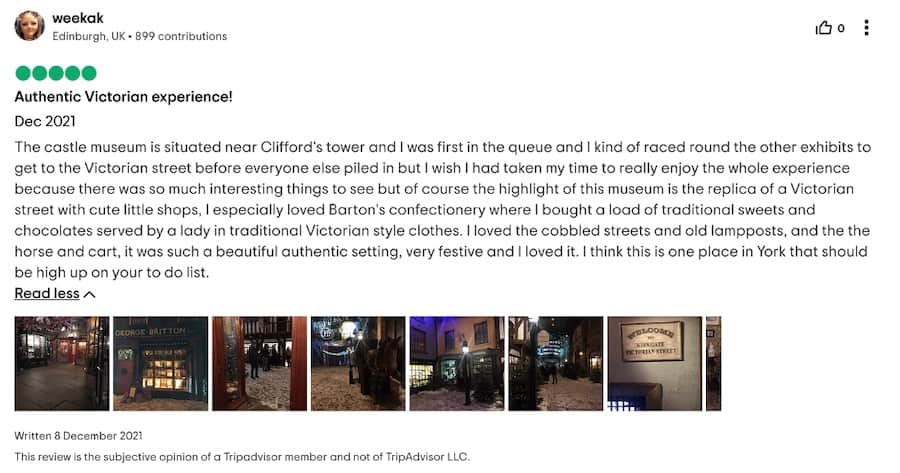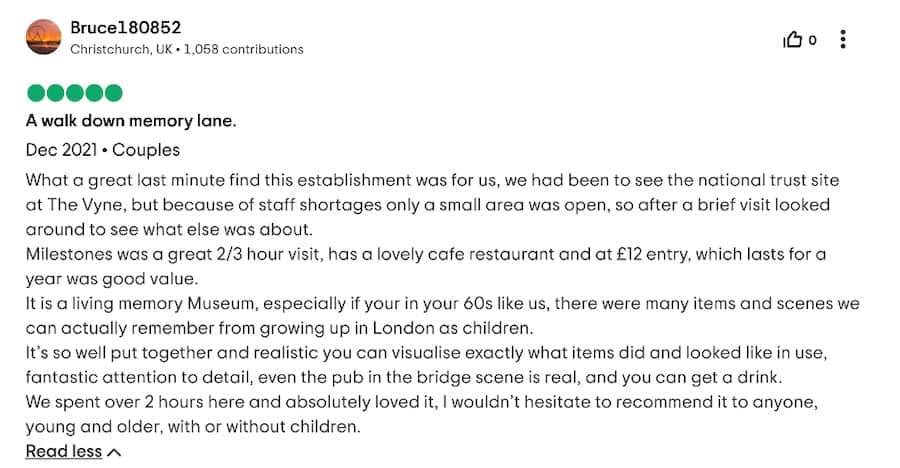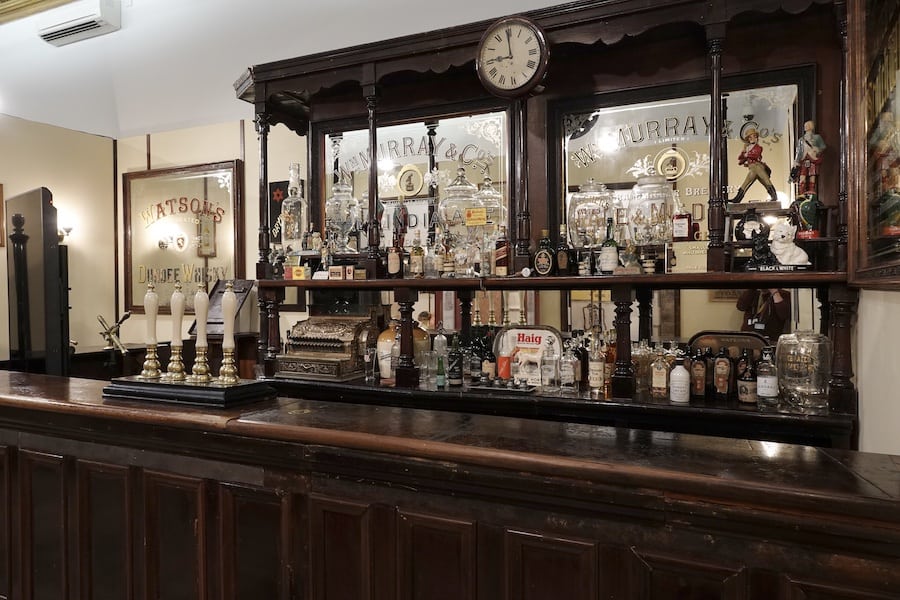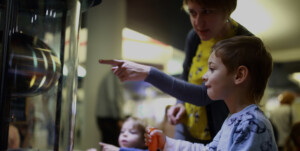Over the Christmas break, I visited The Street, a new exhibition at The McManus: Dundee’s Art Gallery and Museum. One of the exhibition galleries has been transformed into a reconstructed historic street, with the help of set builders from Dundee Rep and Scottish Dance Theatre.
It is packed with objects from The McManus collection. The shop names are familiar to most Dundonians of a certain age, and this was sparking lots of cross-generational conversations and reminiscences amongst the visitors.
Not at the pub!
— Rachel Mackay (@rachmackay) December 16, 2021
I’m at Scotland’s best visitor attraction, @McManusDundee exploring #TheStreet and Dundee’s best known shops and pubs.
It’s a pure joy 🤩 pic.twitter.com/o0DoaPOfUq
According to Trip Advisor, The Street is drawing many lapsed visitors back to the museum. So, with a new addition to the reconstructed street gang on the museum circuit, I set out to explore just what visitors love about a trip down memory lane, and why it keeps them coming back.
Kirkgate
To fully explore the phenomenon, we have to travel back in time to the country’s oldest reconstructed street.
Kirkgate, named after founder Dr John Kirk, was the centrepiece of the York Castle Museum when it opened its doors to the public in 1938. Kirk, a Yorkshire doctor, was concerned about the rapid pace of change at the end of the nineteenth century. Noting that the rural communities he served had undergone less change, he started preserving what he could; gathering objects, curios and household items.
“His aim was to collect as many relics as possible associated with a community whose life style, he believed, was about to be changed radically.” i
Kirk took inspiration from open-air museums in Scandinavia. He wanted to show his collection in a venue full of reconstructed streets of many different periods. However, when this couldn’t be realised, he settled on the vacant Female Prison in York as a site to create York Castle Museum with his collection at the centre. ii
A meticulously reconstructed street
As the York Press reported, “Dr Kirk oversaw every detail of his street’s creation, down to the precise shade of paint for each window. He insisted on skylights so people could see the street in daylight, and specified hot air heating. On arriving to find that the city engineer had installed radiators and hot water pipes, he threatened to withdraw his collection completely.” iii
Kirkgate was an instant hit and remains so to this day. In 2006 it was estimated that over 30 million visitors have walked over its famous cobbles. iv The most used phrase about York Castle Museum on Tripadvisor is ‘Victorian street’. And users are clearly passionate about it:
“I kind of raced round the other exhibits to get to the Victorian street” admits one visitor,v although she admits the rest of the museum is well worth seeing too!
Is nostalgia a good thing?
It’s clear from feedback to York Castle Museum and others, such as Milestones Museum in Basingstoke, that feelings of nostalgia underpin visitors’ love of reconstructed streets. However, museum scholars and professionals remain divided as to whether nostalgia itself is a good thing.
David Lowenthal famously lambasted nostalgia as an outcome of heritage in the 1998 update of his book The Heritage Crusade and the Spoils of History. In the book, Lowenthal decries what he refers to as the “heritage industry” and the increase in our habit of looking to the past to ignore the future.
“Why this rash of backward-looking concern?” he asks in his introduction. “What makes heritage so crucial in a world beset by poverty and hunger, enmity and strife? We seek comfort in past bequests partly to allay these griefs… As hopes of progress fade, heritage consoles us with tradition.” vi
Lowenthal also muses over the populist bent he sees heritage taking. “Formerly about grand monuments, unique treasures and great heroes, heritage now also touts the typical and evokes the vernacular. The homes and haunts of Everyman and Everywoman have spread from Scandinavian open-air museums into historical theme parks the world over.” vii
“Folk museums stress the humdrum over the exquisite” Lowenthal continues. “The ordinary in place of the unusual, the popular rather than the patrician. In re-enacting the past, peasants and artisans now get pride of place.” viii
Telling stories and making connections
The reference to Scandinavian open-air museums (the inspiration for Kirkgate) places reconstructed streets squarely at the target of Lowenthal’s tirade. But why exactly this should be a bad thing remains a mystery to me; along with why peasants and artisans shouldn’t get pride of place.
Most museum professionals today agree that focussing heritage interpretation on more than just history’s “great heroes” ix is probably a good thing. And whilst this part of Lowenthal’s argument smacks strongly of snobbery, his wider assertion, that by dwelling in nostalgia we ignore reality, still resonates.

In her introduction to Heritage Interpretation, Alison Hems of English Heritage questions the approach of making visitors feel as if they have travelled through time. Many historic houses use sounds, lighting or casually placed objects to suggest that historic characters have only just left the room.
Hems acknowledges that many visitors enjoy the feeling of having stepped into another world. But she also highlights the downside of this:
“The previous inhabitants of historic houses have manifestly not just left the room… by pretending that they have, we avoid the need to deal with the changes in values and perceptions that have occurred between the actual then and the fictitious now… The recreation of period interiors from which all traces of modern intrusion have been carefully excluded may also obscure the very meaning and significance that good interpretation should seek to reveal – the stories that otherwise go untold and the connections that remain unmade.” x
The impact of COVID-19
In exploring reconstructed streets today, we must also consider the impact of the current pandemic.
After all, Lowenthal himself points to the fact that periods of upheaval make heritage pursuits more popular. He says that “dismay at massive change stokes demands for heritage.” xi
When he says: “In recoiling from grievous loss or fending off a fearsome future, people the world over revert to ancestral legacies”, it sounds more like he’s talking to us from recent pandemic years than the relatively halcyon days of the late nineties.
Just as the Golden Age of murder fiction dates back to a time when people turned to cosy, fireside mystery books as an anecdote to the horrors of the First World War, nostalgia can bring comfort in times of stress and change.
COVID also brought practical needs to the sector. Operators needed to grapple with the requirements of delivering an immersive environment under changing restrictions. Plus, families also emerged from lockdown looking for places to meet up again, for opportunities for grandparents and children to get to know each other after long absences and to share fun experiences together.
It’s clear that reconstructed streets can address our need for nostalgia. They also facilitate cross-generational sharing and provide fun immersive experiences. However, can they do all that without blinding us to reality and instead, prompting us to think deeper about our own society?
It sounds like a tough ask. Yet many of our much-loved historic streets are making efforts to do exactly that.
Updating memory lane
Today, Kirkgate still remains at the heart of York Castle Museum. However, its purpose has been updated. York Museums Trust, which runs York Castle Museum, says:
“Dr Kirk wanted to create a street scene where people felt that they were transported to a by-gone age. When it first opened, many shops and locations were named after people who had helped to found the museum.” xii
However, in 2012, York Museums Trust undertook a massive restoration and redisplay of Kirkgate. The essence of the street; its cobblestone road and its twee Victorian shop fronts are still in place. But, following rigorous research, the museum narrowed the timeframe and renamed the shops and businesses.
“Now,” says York Museums Trust, “each shop and business on Kirkgate is named after a real business that operated in late Victorian York.”
As you go around and speak to the costumed guides, you learn about real life in the 19th century. Not just a sanitised version of it. xiii And it isn’t just affluent, mercantile York that visitors can explore within this reconstructed street. A new alleyway off of Kirkgate, Rowntree Snicket, aims to present the reality of York’s poorest residents.
“It includes a working-class home and was inspired by Seebohm Rowntree’s famous survey of York’s poor, which led to his ground-breaking report, Poverty: A Study of Town Life, published in 1901.” xiv
Here, we see a version of history that incorporates all of York’s nineteenth-century life; no longer just the names of Dr Kirk’s friends.
The reconstructed street at McManus
The Street at the McManus has a less specific chronology and history than Kirkgate. However, this was a deliberate move, according to curator Gareth Jackson-Hunt:
“I have tried not to have a chronology”, he explains. Some of the shop fronts can be dated as Edwardian or Victorian. But The Street also explores shopping and leisure in Dundee up until the present day. For example, in the toy shop, Jackson-Hunt says, you can see a “Victorian rocking horse next to a Sinclair Spectrum.”
The elasticity of the timeline makes for a huge availability of memories to exchange with friends and families. When I visited, my parents told me about trips to the toy shop, pointing out toys they once longed for.
Jackson-Hunt says he has spotted many such cross-generational exchanges in the gallery. “You can see grandparents chatting with grandchildren, one saying “this is what shops looked like when I was wee.”
One Trip Advisor user commented on its broad appeal, saying: “It was chock full of young and old alike.” xv
Nostalgia and contemporary relevance
There’s also an interesting extra layer to the nostalgia at The Street. Just as Kirkgate has become as much an object of reverence as the past it represents, The Street has tapped into the nostalgia Dundonians have for the McManus itself.
The shop and bar featured in the exhibition are museum favourites from the past. They featured in a show called Ale an ’A’thing in 1980. Both now include acquisitions made over the past 40 years. In fact, Jackson-Hunt says that the re-display of these pieces was actually the main premise for creating the exhibition.
Here, there is no effort to deny the attempt to engage with nostalgia, and indeed, why should there be? As Jackson-Hunt puts it, “a bit of nostalgia is always welcome and is a bit of a comfort blanket in the tough times that we have had in the past few years”.
However, the presence of nostalgia doesn’t mean the absence of contemporary relevance. With the increase of online shopping and the pandemic accelerating new retail habits, town centres and high streets are reshaping. Recently we have seen the loss of big retailing names, as well as independent retailers, in city centres across the country. This has highlighted the ever-evolving nature of our high streets.
Like most, Dundee’s city centre has changed dramatically through the decades. The Street explores how shopping and hospitality have shaped our collective experience during this time. I think most would agree it’s an important contemporary conversation to be having.
Conclusion: the relevance of reconstructed streets
All of this isn’t to say there aren’t some bad versions of reconstructed streets: I’m sure there are. But far from being stuck in a time-travel version of the past, the two I’ve explored have evolved from their roots in the preservation of the past. They allow visitors to explore different facets of history and also apply the experience to our own way of living.
They have updated and moved with the times. And they invite us to explore an experience that is, for now, relatable to all of us.
Reconstructed High Streets will be important to us as long as contemporary High Streets are. And, from recent events, I’m not at all certain that’s a sure thing. So, yes, street reconstructions can, when done well, challenge our views of the past. They can also facilitate social exchanges today and help us imagine the future.
And if there’s a little bit of nostalgia in there too, well… why not?
The Street at The McManus: Dundee’s Art Gallery and Museum is open until October 23 2022.
Top image: Former Dundee department store, Draffens, as shown in The Street. Courtesy of The McManus
Sources
i Ryder, Thomas (1987) The Castle Museum, York, England, The Carriage Journal, Vol. 23, No. 1, 19
ii Ryder, Thomas (1987) The Castle Museum, York, England, The Carriage Journal, Vol. 23, No. 1, 19
iii Titley, Chris (2006) York Press, Dr Kirks Vision https://www.yorkpress.co.uk/news/756260.dr-kirks-vision/ 23 January 2022
iv Titley, (2006)
v Trip Advisor (2021) York Castle Museum https://www.tripadvisor.co.uk/Attraction_Review-g186346-d208244-Reviews-York_Castle_Museum-York_North_Yorkshire_England.html 23 January 2022
vi Lowenthal, David (1998) The Heritage Crusade and the Spoils of History, Cambridge University Press, Cambridge, xiii
vii Lowenthal, David (1998) The Heritage Crusade and the Spoils of History, Cambridge University Press, Cambridge, 14
viii Lowenthal, David (1998) The Heritage Crusade and the Spoils of History, Cambridge University Press, Cambridge, 14
ix Lowenthal, David (1998) The Heritage Crusade and the Spoils of History, Cambridge University Press, Cambridge, 14
x Hems, Alison (2006) in ed. Hems, Alison and Blockley, Marion (2006) Heritage Interpretation, Routledge, Oxon, 4
xi Lowenthal, David (1998) The Heritage Crusade and the Spoils of History, Cambridge University Press, Cambridge, 6
xii York Museums Trust (2022) York Castle Museum, Kirkgate: The Victorian Street https://www.yorkcastlemuseum.org.uk/exhibition/kirkgate-the-victorian-street/ 23 January 2022
xiii York Museums Trust (2022) York Castle Museum, Kirkgate: The Victorian Street https://www.yorkcastlemuseum.org.uk/exhibition/kirkgate-the-victorian-street/ 23 January 2022
xiv York Museums Trust (2022) York Castle Museum, Kirkgate: The Victorian Street https://www.yorkcastlemuseum.org.uk/exhibition/kirkgate-the-victorian-street/ 23 January 2022
xv Trip Advisor (2021) The McManus: Dundee’s Art Gallery and Museum Trip Advisor https://www.tripadvisor.co.uk/Attraction_Review-g186518-d1773000-Reviews-The_McManus_Dundee_s_Art_Gallery_Museum-Dundee_Scotland.html 23 January 2022
